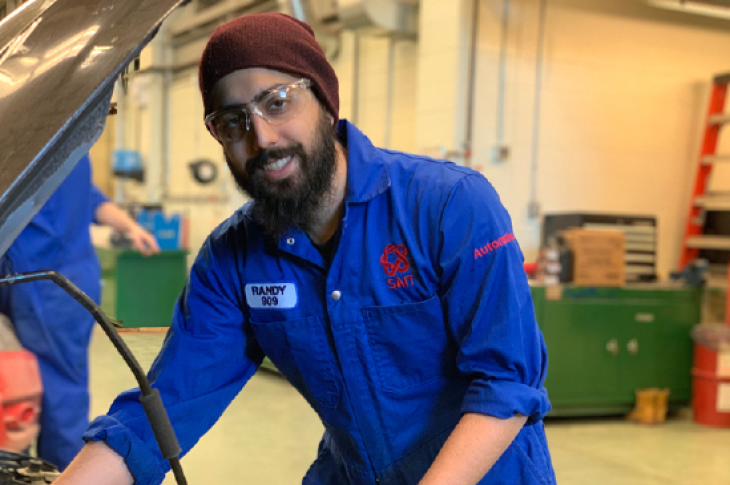Making it happen

Was it easy? No. Was it worth it? Absolutely.
The idea of going back to school can be a daunting one at any age, but the decision to make the investment in yourself and your future is worth taking the plunge.
Randy Dhillon did just that. After realizing he wanted to spend his time solving problems and using his hands to do so, he made the call to come to SAIT.
Randy, 29
Second-year Automotive Service Technology diploma
What were you doing before you began at SAIT?
My background is actually in social work. I worked in that field for a few years and after a while, I noticed I got really fidgety and felt the need to solve problems.
Why did you choose the Automotive Service Technology program?
I knew I wanted to do something more hands-on and I figured working on cars is an essential skill where I can do that and also diagnose problems and learn the skills to solve them.
Did you ever hesitate with the idea of going back to school to change your career?
I was nervous going back to school after having completed a diploma in social work and working in the industry for a few years. I was even more nervous entering a field in which I knew very little about. However, all those rational fears faded away once I began learning. SAIT has an amazing automotive program with supportive faculty members and encouraging professors who are exceptional educators. Being a mature student had its advantages going back to school. Overall, my decision to change careers and purse my education through SAIT was inspirational. I would also like to thank my wife for pushing me and supporting my decision to return to school to improve myself.
What’s your experience in the program been like?
I’ve gotten so much more out of this experience than I had expected. This program is not just learning about how to fix cars — it also teaches you how to connect with industry members and hear what it’s like from their perspective. My experience has shown I got out whatever hard work I put in. All the instructors have taken notice and care about my success in the program. It’s been an incredible journey and I cannot be more thankful to them.
What’s next for you?
I’ve had a job lined up with BMW since my first semester. I actually was one of three students who landed this opportunity thanks to SAIT’s mentorship program with BMW. I’ve been working every Saturday for them while in school and have a full-time job waiting for me once I complete my diploma.
Your last semester likely isn’t wrapping up like you thought it would due to COVID-19. What advice would you give to SAIT students who have transitioned or will be starting their schooling in an online environment?
To those students who are in the midst of finishing here at SAIT my advice is to utilize the time given at home to reflect and power through the last little bit of school work and exams. Use that time to plan and research future prospects for work. Once COVID-19 recedes, opportunities will present themselves.
For new students who are starting up in an online environment, despite the hardship of doing a program online, work hard and establish a strong baseline to work with. The dedication to your studies now will establish a strong foundation once you return to a classroom setting. Altogether we are all in an awkward transition as students. Take the chance to prove yourself and set up goals in which will guide you to success.
Find out more about SAIT programs through our information sessions.
Learning for Life
We prepare students for successful careers and lives.
SAIT'S
2020-2025
Strategic plan

Oki, Âba wathtech, Danit'ada, Tawnshi, Hello.
SAIT is located on the traditional territories of the Niitsitapi (Blackfoot) and the people of Treaty 7 which includes the Siksika, the Piikani, the Kainai, the Tsuut’ina and the Îyârhe Nakoda of Bearspaw, Chiniki and Goodstoney.
We are situated in an area the Blackfoot tribes traditionally called Moh’kinsstis, where the Bow River meets the Elbow River. We now call it the city of Calgary, which is also home to the Métis Nation of Alberta.